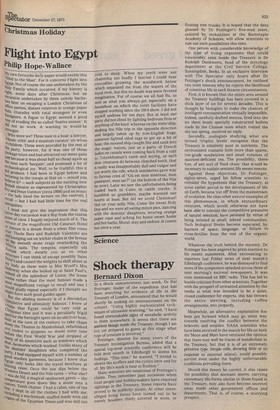Science
Shock therapy
Bernard Dixon
In a shock announcement last week, Dr Hal Pottinger, leader of the expedition that has been searching for evidence of life in the Treasury of London, announced that he would shortly be making an announcement on the subject. "Using highly sophisticated techniques of ultrasonic scanning," he said, "I have found unmistakable signs of metabolic activity in there somewhere. It seems that there are sentient beings inside the Treasury, though I am not yet prepared to guess at this stage what type of creature is involved."
Pottinger, director for many years of the Treasury Investigation Bureau, added that a special top-level scientific conference will be held next month in Edinburgh to assess his findings. "This time," he warned, "I intend to silence the scoffers and the cynics once and for all. My life's work is near to fruition." Many scientists are suspicious of Pottinger's claims, They remember past occasions when local people and holidaymakers have reported sightings in the Treasury. Some reports have proved to be publicity stunts. At other times, alleged living forms have turned out to be merely boulders thinly covered in moss, or floating tree trunks. It is hoped that the data gleaned by Dr Pottinger's five-man team, assisted by technicians at the Barnstaple Academy ot Sciences, will allow scientists to rule out such possibilities this time.
One person with considerable knowledge of the type of living organisms that could conceivably exist inside the Treasury is Dr Rudolph Dankwerts, head of the mycology department at the Civil Service College, Sunningdale, Berks. In an exclusive interview with The Spectator only hours after Dr Pottinger's shock announcement, he outlined two main reasons why he rejects the likelihood of conscious life in such bizarre circumstances.
First, it is known that the entire area around the Treasury buildings has been covered in a thick layer of ice for several decades. This is thought by biologists to make the chances of intelligent communication virtually impossible. Indeed, carefully drafted memos, fired into the ice sheet inside specially constructed bullets made by the Chinese team which visited the site last spring, received no reply.
Secondly, zoologists studying what are termed `tropliic levels' recognise that the Treasury is relatively poor in nutrients. The environment contains little more than sparse, low-grade sandwiches and small volumes of nutrient-deficient tea. The possibility, therefore, of any sort of 'food chain' that would be necessary to sustain sentient life seems remote.
Against these objections. Dr Pottinger, eighty-seven, urged his fellow scientists to consider the hypothesis that the Treasury, at some earlier period in the development of life on Earth, became 'cut off from the mainstream of evolution. He cites other natural examples of this phenomenon, in which extraordinary creatures, which would otherwise not have been able to tolerate the competitive pressures of natural selection, have persisted by virtue of being isolated in small, inbred communities. Such biological freaks become separated, by barriers of space, language, or failure to cross-fertilise from the rest of the organic world.
Whatever the truth behind the mystery, Dr Pottinger has been angered by press reaction to his recent statements. After announcing to reporters last Friday news of next month's Edinburgh conference, he was dismayed to find news of the symposium splashed across three of next morning's national newspapers. It was even mentioned on BBC radio. This has led to hostile criticism from other scientists. Together with the prospect of unwanted attention by the media at what was intended to be a quiet, closed conference for experts, this has thrown the entire meeting, including coffee arrangements, into jeopardy.
Meanwhile, an alternative explanation has been put forward which may go some way towards resolving the conflict between the believers and sceptics. NASA scientists who have been involved in the search for life on both the Moon and Mars have ventured the opinion that there may well be traces of metabolism in the Treasury, but that it is of an extremely primitive type. Simple cells, showing little or no response to external stimuli, could possibly survive even under the highly unfavourable conditions prevailing there.
Should this theory be correct, it also raises the possibility that dormant spores, carrying elementary life-forms similar to those found in the Treasury, may also have become secreted away inside other government offices and departments. That is, of course, a worrying prospect.


































 Previous page
Previous page